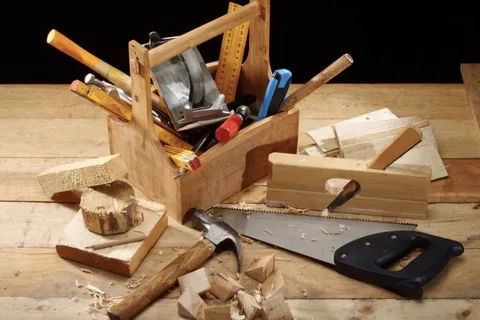
Woodworking is a timeless craft that allows individuals to unleash their creativity and create beautiful, functional pieces from raw materials. Whether you’re interested in building furniture, crafting decorations, or tackling home improvement projects, having the right tools is essential for success. In this beginner’s guide to woodworking, we’ll explore the must-have tools every aspiring woodworker should add to their toolkit. From measuring and cutting to shaping and finishing, let’s embark on a journey into the world of woodworking tools and techniques.
Why Woodworking Tools Matter:
Before we delve into the specific tools needed for woodworking, let’s discuss why having the right tools is crucial for beginners. Firstly, the quality of your tools can greatly impact the outcome of your woodworking projects, ensuring precision and durability in your craftsmanship. Secondly, using the appropriate tools can streamline the woodworking process, making tasks more efficient and enjoyable. Lastly, investing in essential woodworking tools sets a solid foundation for skill development and project versatility as you continue to hone your craft.
Essential Woodworking Tools:
- Measuring Tools: Accurate measurements are fundamental to woodworking projects. Start with a reliable tape measure for general measurements, and add a combination square and a carpenter’s square for precise angles and alignments.
- Saw: A quality saw is indispensable for cutting wood to size. For beginners, a versatile handsaw or a circular saw with a guide rail attachment is ideal for making straight cuts, while a coping saw or a jigsaw can handle curved or intricate cuts.
- Power Drill and Bits: From drilling pilot holes to driving screws, a power drill is essential for woodworking projects. Invest in a cordless drill with a variety of drill bits and screwdriver bits to tackle different materials and fasteners.
- Chisels: Chisels are indispensable for woodworking tasks such as carving, shaping, and detailing. Start with a basic set of beveled-edge chisels in various sizes, and gradually add specialty chisels as you expand your skills and projects.
- Hammer and Mallet: A hammer is a versatile tool for driving nails and tapping components into place, while a mallet is gentler and ideal for striking chisels and assembling joinery without damaging delicate surfaces.
- Hand Planes: Hand planes are essential for smoothing and flattening wood surfaces. Begin with a block plane for chamfering edges and smoothing small surfaces, and consider adding a bench plane for larger flattening and shaping tasks.
- Spanners: Spanners are crucial for tightening or loosening bolts and nuts in woodworking projects, ensuring stability and durability in assembled pieces.
- Clamps: Clamps are indispensable for holding pieces of wood securely in place during assembly, gluing, and clamping. Start with a variety of bar clamps and spring clamps in different sizes to accommodate various project sizes and shapes.
- Sanding Tools: Sanding is a crucial step in woodworking to achieve smooth, polished surfaces. Invest in a combination of sandpaper in different grits, a sanding block for flat surfaces, and a random orbital sander for larger projects.
- Safety Gear: Prioritize safety by wearing appropriate protective gear, including safety glasses, hearing protection, and a dust mask, especially when working with power tools and handling sawdust and wood chips.
Planning Your Woodworking Projects:
Before diving into your first woodworking project, take the time to plan and prepare for success. Start by selecting a project that matches your skill level and interests, whether it’s a simple cutting board, a basic bookshelf, or a decorative wall hanging. Gather all the necessary materials and tools, and create a detailed plan or blueprint to guide you through each step of the project. Consider factors such as wood species, dimensions, joinery techniques, and finishing options to ensure a satisfying and successful woodworking experience.
Getting Started with Woodworking:
With your tools and materials in hand, it’s time to embark on your woodworking journey. Start by familiarizing yourself with each tool and its proper use, practicing basic techniques such as measuring, cutting, drilling, and sanding. Take your time to work methodically and accurately, paying attention to detail and precision in every step of the process. Don’t be afraid to make mistakes – they’re an essential part of the learning process in woodworking. Embrace the opportunity to learn from your experiences and improve your skills with each project you undertake.
Exploring Woodworking Techniques:
As you gain confidence and proficiency in basic woodworking skills, expand your repertoire by exploring different techniques and joinery methods. Experiment with hand-cut dovetails, mortise and tenon joints, and box joints to create strong and visually appealing connections in your projects. Explore the art of wood carving, turning, and shaping to add intricate details and decorative elements to your workpieces. Remember that woodworking is a journey of continuous learning and growth, so don’t hesitate to seek inspiration, guidance, and feedback from experienced woodworkers and online communities.
Conclusion:
Woodworking is a rewarding and fulfilling hobby that allows individuals to unleash their creativity and craftsmanship while creating beautiful, functional pieces from raw materials. By equipping yourself with the right tools, knowledge, and passion for the craft, you can embark on a journey of exploration, learning, and self-expression through woodworking. Whether you’re a beginner just starting out or an experienced woodworker honing your skills, remember that every project is an opportunity to challenge yourself, expand your abilities, and bring your creative visions to life. Happy woodworking!
